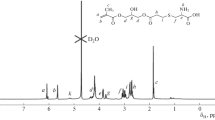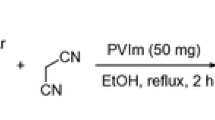Abstract
In this study, chiral dicarboxylic acid monomer of 2,2′-(1,4-phenylene) bis(4,5-dihydrothiazole-4-carboxylic acid) was first prepared by the reaction of 1,4 -dicyanobenzene and L-cysteine. Afterward, novel optically active and aromatic polyamides (PAs) were synthesized by polycondensation of L-cysteine-based diacid and different aromatic diamines in molten tetrabutylammonium bromide. PAs, which were obtained in good yields, showed high thermal stability as well as inherent viscosities in the range of 0.33–0.40 dL/g. FT-IR, 1HNMR, elemental analysis, and thermogravimetric analysis were used to characterize the chemical structure of the synthetic polymers. Field emission scanning electron microscopy and X-ray powder diffraction methods were used to determine the surface morphology and crystallinity of the polymers, respectively. In addition, the PAs have been tested against the Escherichia coli and Staphylococcus aureus as known gram-negative and gram-positive bacteria, respectively. The antimicrobial activity of Escherichia coli and Staphylococcus aureus indicated minimum inhibitory concentration and minimum bactericidal concentration of 62–125 and 125–250 μg/mL, respectively, while the corresponding values for Staphylococcus aureus were 62–250 and 125–500 μg/mL, respectively.










Similar content being viewed by others
References
Centres for Disease Control and Prevention, US Department of Health and Human Services (2013) Antibiotic resistance threats in the United States. Atlanta: CDC. Available from: https://www.cdc.gov/drugresistance/pdf/threats-report/2019-ar-threats-report-508.pdf.
Kenawy E-R, Worley S, Broughton R (2007) The chemistry and applications of antimicrobial polymers: a state-of-the-art review. Biomacromol 8:1359–1384
Park ES, Lee HJ, Park HY, Kim MN, Chung KH, Yoon JS (2001) Antifungal effect of carbendazim supported on poly (ethylene-co-vinyl alcohol) and epoxy resin. J Appl Polym Sci 80:728–736
Sardi JDCO, Pitangui NS, Gullo FP, Almeida AMF, Mendes-Giannini MJS (2013) A mini review of Candida species in hospital infection: epidemiology, virulence factor and drugs resistance and prophylaxis. Trop Med Surg 1:1–7
Padmanabhuni RV (2012) Novel antimicrobial and biofilm-controlling cellulosic polymers. University of South Dakota.
Moulana Z, Ghaemi M, Qasemi S, Ghassemi K, HasanjaniRoushan MR, Tashakkorian H et al (2017) Synthesis, antibacterial evaluation and survey on the thermophysical characteristics of novel medically applicable polyamides containing pharmaceutically outstanding triazole moieties. J Macromol Sci Part A 54:30–39
Francisco DL, Paiva LB, Aldeia W (2019) Advances in polyamide nanocomposites: a review. Polym Compos 40:851–870
Mallakpour S, Dinari M (2013) Straightforward and green method for the synthesis of nanostructure poly(amide-imide)s-containing benzimidazole and amino acid moieties by microwave irradiation. Polym Bull 70:1049–1064
Venoor V, Park JH, Kazmer DO, Sobkowicz MJ (2020) Understanding the effect of water in polyamides: a review. Polym Rev, pp 1–49
Higashi F, Nishi T (1986) Direct polyamidation with thionyl chloride in N-methyl-pyrrolidone. J Polym Sci Part A Polym Chem 24:701–706
Hajibeygi M, Habibnejad N, Shabanian M, Khonakdar HA (2021) Fabrication and study of thermal and combustion resistance of DOPO-functionalized polyamide reinforced with organo-modified Mg(OH)2 nanoparticles. Polym Int 70:317–330
Hsiao SH, Wu CN (2017) Solution‐processable and electroactive aromatic polyamides with 3, 5‐bis (trifluoromethyl) triphenylamine moiety. Polym Int, 66:916–924
Liu Y, Liu T, Pang L, Guo J, Wang J, Qi D et al (2020) Novel triphenylamine polyamides bearing carbazole and aniline substituents for multi-colored electrochromic applications. Dyes Pigments 173:107995
Modiri-Delshad T, Khoobi M, Shabanian M, Khonakdar H, A. Shafiee A. (2018) Synthesis, thermal and combustion properties of new polyamide/amidoacid@ Fe3O4 nanocomposite. Adv Polym Technol 37:559–565
Mallakpour S, Dinari M (2009) Preparation of thermally stable and optically active organosoluble aromatic polyamides containing L-leucine amino acid under green conditions. Polym Bull 63:623
Andreo-Martínez P, Ortiz-Martínez V, Quesada-Medina J (2020) Ionic liquids as solvents and catalysts for biodiesel production. In: Nanotechnology-based industrial applications of ionic liquids. Springer, pp 37–50
Mallakpour S, Dinari M (2011) High performance polymers in ionic liquid: a review on prospects for green polymer chemistry. Part II: Polyimides and polyesters. Iran Polym J 20:259–279
Mallakpour S, Dinari M (2012) Ionic liquids as green solvents: progress and prospects. In: Mohammad A, Inamuddin D (eds) Green solvents II. Springer, Dordrecht.
Gildeh SFG, Roohi H, Mehrdad M, Rad-Moghadam K, Ghauri K (2020) Experimental and theoretical probing of the physicochemical properties of ionic liquids composed of [Bn-DBU]+ cation and various anions. J Mol Struct 1202:127226
Ortiz-Martínez V, Salar-García M (2020) Separation of volatile organic compounds by using immobilized ionic liquids. In Green sustainable process for chemical and environmental engineering and science, Elsevier, pp 105–122
Mallakpour S, Dinari M (2010) A study of the ionic liquid mediated microwave heating for the synthesis of new thermally stable and optically active aromatic polyamides under green procedure. Macromol Res 18:129–136
Dinari M, Haghighi A (2017) Synthesis and characterization of new heat-resistant polyamides bearing an s-triazine ring under green conditions. J Polym Res , 24:1–9
Mallakpour S, Dinari M (2012) Novel nanostructure amino acid-based poly (amide–imide) s enclosing benzimidazole pendant group in green medium: fabrication and characterization. Amino Acids 43:1605–1613
Mallakpour S, Dinari M (2010) High performance polymers in ionic liquids: a review on prospects for green polymer chemistry Part I: polyamides. Iran Polym J 19:983–1004
Mallakpour S, Zadehnazari A (2013) The production of functionalized multiwall carbon nanotube/amino acid-based poly (amide–imide) composites containing a pendant dopamine moiety. Carbon 56:27–37
Malik AU, Zhou XL, Kong SN, Li LL, Bao XL, Shu MH (2018) Homochiral hexanuclear nickel(ii) metallocyclic structures with high activity for the photocatalytic degradation of organic dyes. Dalton Trans 47:1764–1767
Mizuno K, Takeuchi K, Umehara K, Nakajima M (2018) Identification of a novel metabolite of vildagliptin in humans: cysteine targets the nitrile moiety to form a thiazoline ring. Biochem Pharmacol 156:312–321
Van Krevelen DW, Hoftyzer PJ (1976) Properties of polymers, 3rd edn. Elsevier, New York
Dinari M, Hatami M (2019) Novel N-riched crystalline covalent organic framework as a highly porous adsorbent for effective cadmium removal. J Environ Chem Eng 7:102907
Mahon CR, Lehman DC, Manuselis G (2011) Textbook of diagnostic microbiology, 4th edn. W. B. Saunders Co., Philadelphia
Ghaemy M, Aghakhani B, Taghavi M, Nasab SMA, Mohseni M (2013) Synthesis and characterization of new imidazole and fluorene–bisphenol based polyamides: thermal, photophysical and antibacterial properties. React Funct Polym 73:555–563
Acknowledgments
The authors wish to thank the research council of the Isfahan University of Technology.
Author information
Authors and Affiliations
Corresponding author
Ethics declarations
Conflict of interest
The authors declare no competing financial interest.
Additional information
Publisher's Note
Springer Nature remains neutral with regard to jurisdictional claims in published maps and institutional affiliations.
Rights and permissions
About this article
Cite this article
Dinari, M., Fardmanesh, K., Maleki, M.H. et al. Synthesis, characterization and antimicrobial properties of new L-cysteine based chiral aromatic polyamides. Polym. Bull. 79, 11103–11117 (2022). https://doi.org/10.1007/s00289-021-04020-1
Received:
Revised:
Accepted:
Published:
Issue Date:
DOI: https://doi.org/10.1007/s00289-021-04020-1




